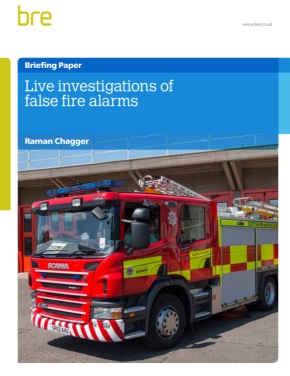Live investigations of false fire alarms
Live investigations of false fire alarms was written by Raman Chagger and published by BRE in December 2015. Recommendations made as a result of this project can help to significantly reduce the occurrence of false fire alarms.
Fire detection and fire alarm systems (FDFAS) are used to provide early warning of fire in order to alert the local Fire and Rescue Service (FRS). FRS attendance at fires saves lives, prevents injury and reduces associated property damage costs.
However, false alarms attribute to estimated losses of around £1 billion a year, resulting in disruption and loss of productivity for businesses. False alarms have the potential to divert fire and rescue services away from real fires, and also reduce the confidence of the general public in fire alarms. Despite this there is no single organisation responsible for investigating false alarms or providing guidance on reducing them.
This research aimed to identify the fundamental causes of false fire alarms, utilising a fire alarm industry expert to investigate false alarms as they occurred in the field in the greater Glasgow area. A comprehensive online questionnaire containing 124 questions was developed to enable the fire alarm investigator to record all details of the false alarms attended. This form of live investigation of false alarms had not previously been attempted. The fire alarm investigator assisted Scottish Fire and Rescue Service crews as they attended live callouts and, following a comprehensive investigation, completed online reports for each false alarm.
Data from his accounts and from 65 false alarm reports, gathered from November 2014 to April 2015, were analysed and 35 recommendations were made. These can significantly reduce false alarm occurrences and contribute to the greater integrity and reliability of fire detection systems.
The recommendations were made across nine different stakeholder groups, ensuring that fire and rescue services, fire risk assessors, business owners, fire alarm contractors, trade associations and others can all play their part in collectively reducing false alarms in the UK.
The contents of the briefing paper are:
- Summary.
- Abbreviations and glossary of terms.
- Introduction.
- Methodology.
- Summary of data gathered.
- Findings and recommendations.
- Future work.
- Conclusions.
- References.
The free briefing paper can be downloaded at: https://files.bregroup.com/research/Live-Investigations-of-False-Alarms_2015-December.pdf
[edit] Related articles on Designing Buildings Wiki
- BRE articles on Designing Buildings Wiki.
- Carbon monoxide detector.
- Fire detection and alarm system.
- Fire protection engineering.
- Fire.
- Heat alarm.
- Ionisation smoke alarm.
- Multi-sensor alarm.
- New requirements for fire detection and alarm network systems IP 12 13.
- Optical smoke alarm.
- Over £1 billion lost every year due to false alarms.
- Project SHOUT.
- Smoke alarm.
- The causes of false fire alarms in buildings.
Featured articles and news
Homes England supports Greencore Homes
42 new build affordable sustainable homes in Oxfordshire.
Zero carbon social housing: unlocking brownfield potential
Seven ZEDpod strategies for brownfield housing success.
CIOB report; a blueprint for SDGs and the built environment
Pairing the Sustainable Development Goals with projects.
Types, tests, standards and fires relating to external cladding
Brief descriptions with an extensive list of fires for review.
Latest Build UK Building Safety Regime explainer published
Key elements in one short, now updated document.
UKGBC launch the UK Climate Resilience Roadmap
First guidance of its kind on direct climate impacts for the built environment and how it can adapt.
CLC Health, Safety and Wellbeing Strategy 2025
Launched by the Minister for Industry to look at fatalities on site, improving mental health and other issues.
One of the most impressive Victorian architects. Book review.
Common Assessment Standard now with building safety
New CAS update now includes mandatory building safety questions.
RTPI leader to become new CIOB Chief Executive Officer
Dr Victoria Hills MRTPI, FICE to take over after Caroline Gumble’s departure.
Social and affordable housing, a long term plan for delivery
The “Delivering a Decade of Renewal for Social and Affordable Housing” strategy sets out future path.
A change to adoptive architecture
Effects of global weather warming on architectural detailing, material choice and human interaction.
The proposed publicly owned and backed subsidiary of Homes England, to facilitate new homes.
How big is the problem and what can we do to mitigate the effects?
Overheating guidance and tools for building designers
A number of cool guides to help with the heat.
The UK's Modern Industrial Strategy: A 10 year plan
Previous consultation criticism, current key elements and general support with some persisting reservations.
Building Safety Regulator reforms
New roles, new staff and a new fast track service pave the way for a single construction regulator.
























